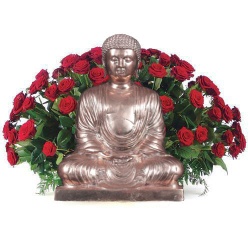Difference between revisions of "How Citta Conditions Rupa"
(Created page with " Citta (mind) plays a part in {{Wiki|conditioning}} the rupa caused by kamma. The rupa (body) has to follow the will of the mind. Citta co...") |
|||
| Line 1: | Line 1: | ||
| − | + | [[File:Bb8vbZbT.jpg|thumb|250px|]] | |
| − | [[Citta]] ([[mind]]) plays a part in {{Wiki|conditioning}} the [[rupa]] [[caused]] by [[kamma]]. The [[rupa]] ([[body]]) has to follow the will of the [[mind]]. [[Citta]] commands the [[body]] to sit, [[sleep]], stand or move. When the will to moves arises, | + | [[Citta]] ([[mind]]) plays a part in {{Wiki|conditioning}} the [[rupa]] [[caused]] by [[kamma]]. The [[rupa]] ([[body]]) has to follow the will of the [[mind]]. [[Citta]] commands the [[body]] to sit, [[sleep]], stand or move. When the will to moves arises, [[cittaja rupa]] pervades the entire [[body]]. [[Vayo dhatu]] is dominant in [[cittaja rupa]] i.e. it is more active than usual. So the [[body]] becomes alert. |
| − | The number of kalapas dominated by [[vayo | + | The number of [[kalapas]] dominated by [[vayo dhatu]] increase gradually, causing the [[body]] to move according to the dictates of [[mind]]. [[Bodily]] movements are similar to those of the pictures in {{Wiki|motion}} picture. One frame shows a man [[standing]]; the next shows the [[arising]] of one leg; then the putting down of that leg and so on. The quick {{Wiki|movement}} of hundreds of frames is seen as a man walking. |
| − | In like [[manner]], when a man takes a walk, the process [[beings]] with the [[Wikipedia:Volition (psychology)|volition]] of the [[mind]]. The [[vaya | + | In like [[manner]], when a man takes a walk, the process [[beings]] with the [[Wikipedia:Volition (psychology)|volition]] of the [[mind]]. The [[vaya dhatu]] is the first [[rupa]] becomes alert. The second [[rupa]] comes into being not in the original position but somewhere closely adjacent. The next, and the next [[rupa]] appear and disappear in adjacent position in rapid succession. As millions of such {{Wiki|processes}} happen within the wink of an [[eye]] this is seen as a man-walking step after step. |
| − | There is a saying, "Young at [[heart]], youthful looks". When one is in [[happy]] [[mood]], the | + | There is a saying, "Young at [[heart]], youthful looks". When one is in [[happy]] [[mood]], the [[cittaja rupas]] are cheerful. When in amiable [[conversation]], one's facial expression is that of gaiety. When one is {{Wiki|despair}} the [[rupa]] becomes correspondingly downcast. When a quarrelsome [[conversation]] the facial expression portrays [[wrath]]. |
| − | When a house catches [[fire]], the flames spread to the houses nearby. Similarly, when | + | When a house catches [[fire]], the flames spread to the houses nearby. Similarly, when [[sittaja rupa]] is in agony, the [[rupas]] also [[suffer]] from {{Wiki|equal}} agony, the [[rupas]] in {{Wiki|conjunction}} namely [[kammaja]], [[utaja]] and [[aharaja rupas]] also [[suffer]] from {{Wiki|equal}} agony. So when a [[person]] is very dejected his features look very aged; when the anguish is extreme he [[dies]] broken-hearted. To sum up, the [[citta]] ([[mind]]) c onditions your [[body]] from the very beginning of pregnancy. |
| + | {{R}} | ||
| + | [http://www.wisdomlib.org/buddhism/book/abhidhamma-in-daily-life_2/d/doc3195.html www.wisdomlib.org] | ||
| + | [[Category:Rupa]] | ||
Latest revision as of 08:01, 3 April 2014
Citta (mind) plays a part in conditioning the rupa caused by kamma. The rupa (body) has to follow the will of the mind. Citta commands the body to sit, sleep, stand or move. When the will to moves arises, cittaja rupa pervades the entire body. Vayo dhatu is dominant in cittaja rupa i.e. it is more active than usual. So the body becomes alert.
The number of kalapas dominated by vayo dhatu increase gradually, causing the body to move according to the dictates of mind. Bodily movements are similar to those of the pictures in motion picture. One frame shows a man standing; the next shows the arising of one leg; then the putting down of that leg and so on. The quick movement of hundreds of frames is seen as a man walking.
In like manner, when a man takes a walk, the process beings with the volition of the mind. The vaya dhatu is the first rupa becomes alert. The second rupa comes into being not in the original position but somewhere closely adjacent. The next, and the next rupa appear and disappear in adjacent position in rapid succession. As millions of such processes happen within the wink of an eye this is seen as a man-walking step after step.
There is a saying, "Young at heart, youthful looks". When one is in happy mood, the cittaja rupas are cheerful. When in amiable conversation, one's facial expression is that of gaiety. When one is despair the rupa becomes correspondingly downcast. When a quarrelsome conversation the facial expression portrays wrath.
When a house catches fire, the flames spread to the houses nearby. Similarly, when sittaja rupa is in agony, the rupas also suffer from equal agony, the rupas in conjunction namely kammaja, utaja and aharaja rupas also suffer from equal agony. So when a person is very dejected his features look very aged; when the anguish is extreme he dies broken-hearted. To sum up, the citta (mind) c onditions your body from the very beginning of pregnancy.
